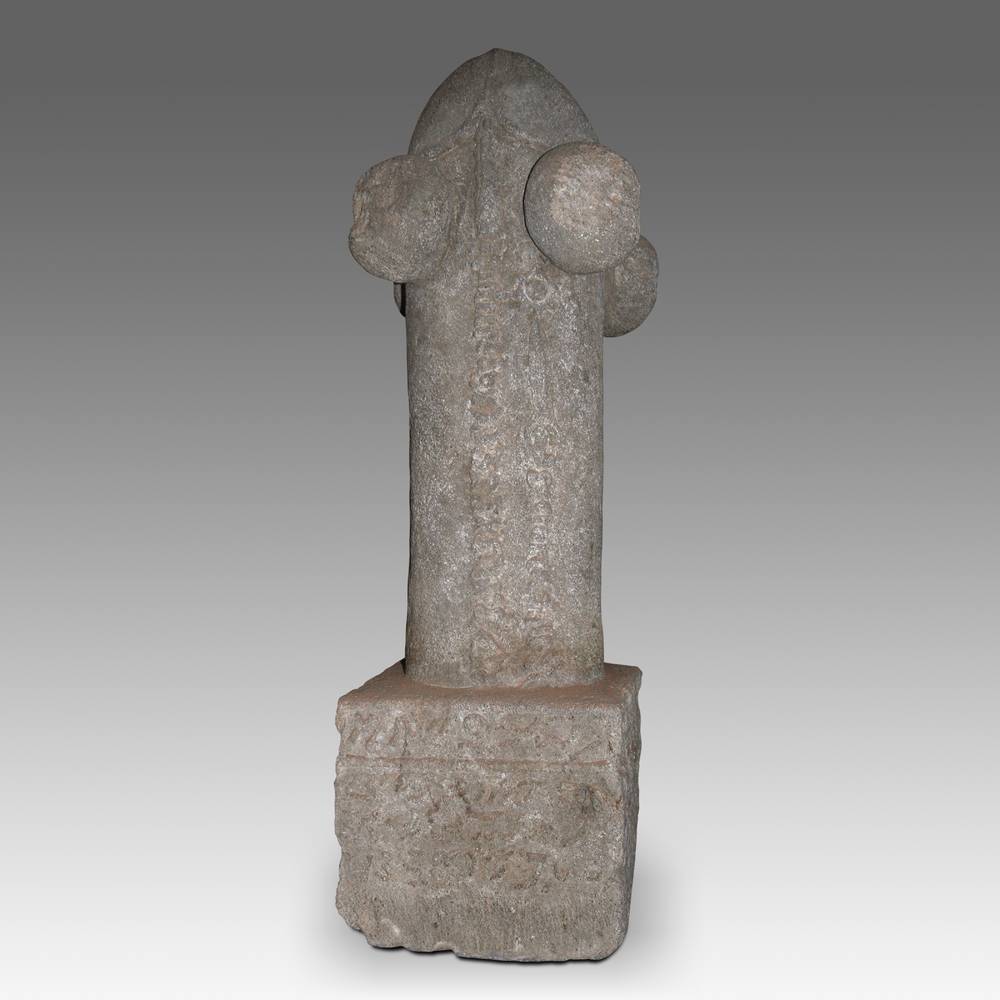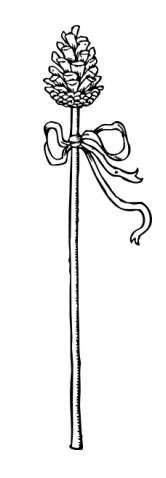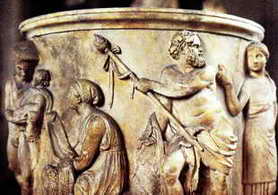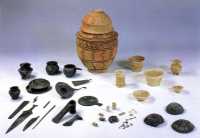Mirror: http://tinyurl.com/nj99l85
Peacock, pine cone, fish are Meluhha hieroglyphs. These hieroglyphs signify one category of life during Bronze Age: metalwork.
Pine cone and peacocks in bronze and fish are Meluhha hieroglyphs like Indus Script Cipher. They belong to kole.l ‘smithy, temple’ (Kota). See: https://www.academia.edu/12804348/Two_bronze_peacocks_11_ft._high_bronze_pine_cone_at_Vatican_are_Meluhha_hieroglyphs_metalwork_catalogues._Archaemetallurgical_analyses_by_Vatican_suggested
![]() What is described as a “pinecone” at the small museum at Arbeia (South Shields, near Newcastle-upon-Tyne, U.K.), which was found in Romano-British context.
What is described as a “pinecone” at the small museum at Arbeia (South Shields, near Newcastle-upon-Tyne, U.K.), which was found in Romano-British context.
https://aediculaantinoi.wordpress.com/2012/04/06/megalensia-the-third-day/
![]()
See: http://bharatkalyan97.blogspot.in/2015/05/rigveda-soma-not-herb-not-drink-but.html A tree associated with smelter and linga from Bhuteshwar, Mathura Museum. Architectural fragment with relief showing winged dwarfs (or gaNa) worshipping with flower garlands, Siva Linga. Bhuteshwar, ca. 2nd cent BCE. Lingam is on a platform with wall under a pipal tree encircled by railing. (Srivastava, AK, 1999, Catalogue of Saiva sculptures in Government Museum, Mathura: 47, GMM 52.3625) The tree is a phonetic determinant of the smelter indicated by the railing around the linga: kuṭa, °ṭi -- , °ṭha -- 3, °ṭhi -- m. ʻ tree ʼ Rebus: kuṭhi 'smelter'. kuṭa, °ṭi -- , °ṭha -- 3, °ṭhi -- m. ʻ tree ʼ lex., °ṭaka -- m. ʻ a kind of tree ʼ Kauś.Pk. kuḍa -- m. ʻ tree ʼ; Paš. lauṛ. kuṛāˊ ʻ tree ʼ, dar. kaṛék ʻ tree, oak ʼ ~ Par. kōṛ ʻ stick ʼ IIFL iii 3, 98. (CDIAL 3228). See:
This museum artifact is comparable to the monumental 6 ft. tall inscribed stone linga discovered in Candi Sukuh as the sacred, venerated pillar of light, described in Atharva Veda Stambha Sukta.
![]()
![]()
![]()
gaṇḍa -- m. ʻ four' (Munda) गंडा[ gaṇḍā ] m An aggregate of four (cowries or pice). (Marathi) <ganDa>(P) {NUM} ``^four''. Syn. <cari>(LS4), <hunja-mi>(D). *Sa., Mu.<ganDa> `id.', H.<gA~Da> `a group of four cowries'. %10591. #10511.<ganDa-mi>(KM) {NUM} ``^four''. |<-mi> `one'. %10600. #10520. Ju<ganDa>(P) {NUM} ``^four''. gaṇḍaka m. ʻ a coin worth four cowries ʼ lex., ʻ method of counting by fours ʼ W. [← Mu. Przyluski RoczOrj iv 234]S. g̠aṇḍho m. ʻ four in counting ʼ; P. gaṇḍā m. ʻ four cowries ʼ; B. Or. H. gaṇḍā m. ʻ a group of four, four cowries ʼ; M. gaṇḍā m. ʻ aggregate of four cowries or pice ʼ.(CDIAL 4001)
``^penis'':So. laj(R)~ lij ~ la'a'j~ laJ/ laj~ kaD `penis'.
Hieroglyph: kanda m. bulbous root (Samskritam) Ash. piċ-- kandə ʻ pine ʼ Rebus:lo-khānḍa 'tools, pots and pans, metal-ware'. लोखंड [lōkhaṇḍa ] 'metalwork' Rebus: loh 'copper, iron, metal' (Indian sprachbund, Meluhha).
![]() Thyrsus staff tied with taenia and topped with a pine cone
Thyrsus staff tied with taenia and topped with a pine cone
![The Braschi Antinous]() Cat. 256
Cat. 256
![]() http://cache2.allpostersimages.com/p/LRG/50/5087/FRK2G00Z/affiches/vase-dit-a-la-cachette-et-une-partie-de-son-depot.jpg The vase a la cachette, shown with its contents. Acropole mound, Susa. Old Elamite period, ca. 2500 – 2400 BCE. Clay. H 201/4 in. (51 cm) Paris. Musee du Louvre. Sb 2723.
http://cache2.allpostersimages.com/p/LRG/50/5087/FRK2G00Z/affiches/vase-dit-a-la-cachette-et-une-partie-de-son-depot.jpg The vase a la cachette, shown with its contents. Acropole mound, Susa. Old Elamite period, ca. 2500 – 2400 BCE. Clay. H 201/4 in. (51 cm) Paris. Musee du Louvre. Sb 2723.![]()
Peacock, pine cone, fish are Meluhha hieroglyphs. These hieroglyphs signify one category of life during Bronze Age: metalwork.
Pine cone and peacocks in bronze and fish are Meluhha hieroglyphs like Indus Script Cipher. They belong to kole.l ‘smithy, temple’ (Kota). See: https://www.academia.edu/12804348/Two_bronze_peacocks_11_ft._high_bronze_pine_cone_at_Vatican_are_Meluhha_hieroglyphs_metalwork_catalogues._Archaemetallurgical_analyses_by_Vatican_suggested
 What is described as a “pinecone” at the small museum at Arbeia (South Shields, near Newcastle-upon-Tyne, U.K.), which was found in Romano-British context.
What is described as a “pinecone” at the small museum at Arbeia (South Shields, near Newcastle-upon-Tyne, U.K.), which was found in Romano-British context.https://aediculaantinoi.wordpress.com/2012/04/06/megalensia-the-third-day/

See: http://bharatkalyan97.blogspot.in/2015/05/rigveda-soma-not-herb-not-drink-but.html A tree associated with smelter and linga from Bhuteshwar, Mathura Museum. Architectural fragment with relief showing winged dwarfs (or gaNa) worshipping with flower garlands, Siva Linga. Bhuteshwar, ca. 2nd cent BCE. Lingam is on a platform with wall under a pipal tree encircled by railing. (Srivastava, AK, 1999, Catalogue of Saiva sculptures in Government Museum, Mathura: 47, GMM 52.3625) The tree is a phonetic determinant of the smelter indicated by the railing around the linga: kuṭa, °ṭi -- , °ṭha -- 3, °ṭhi -- m. ʻ tree ʼ Rebus: kuṭhi 'smelter'. kuṭa, °ṭi -- , °ṭha -- 3, °ṭhi -- m. ʻ tree ʼ lex., °ṭaka -- m. ʻ a kind of tree ʼ Kauś.Pk. kuḍa -- m. ʻ tree ʼ; Paš. lauṛ. kuṛāˊ ʻ tree ʼ, dar. kaṛék ʻ tree, oak ʼ ~ Par. kōṛ ʻ stick ʼ IIFL iii 3, 98. (CDIAL 3228). See:
This museum artifact is comparable to the monumental 6 ft. tall inscribed stone linga discovered in Candi Sukuh as the sacred, venerated pillar of light, described in Atharva Veda Stambha Sukta.
Candi Cetho. Lingga shows a pair of balls at the top of the penis -- to be read rebus as Meluhha hieroglyph composition: lo-khaNDa, penis + 4 balls; Rebus: iron, metalware.
The four balls of the penis are also clearly shown on a 6 ft. tall linga inscribed with 1. a sword; and 2. inscription in Javanese, referring to 'inauguration of the holy ganggasudhi...'



See: http://bharatkalyan97.blogspot.in/2015/01/sekkizhar-periya-puranam-candi-sukuh.html Histoire ancienne des Etats hindouises along the Tin Road from Haifa to Hanoi. NaMo, Obama, announce United Indian Ocean States.
lo 'penis' Rebus: loh 'copper, metal'
Hieroglyphs: gaṇḍa 'swelling' gaṇḍa 'four' gaṇḍa 'sword'
Rebus: kāṇḍa ‘tools, pots and pans and metal-ware’ (Marathi)
Together, hieroglyphs: lo + gaṇḍa. Rebus: लोखंड [ lōkhaṇḍa ] 'metalwork'
Metaphor: Sh. K.ḍoḍ. lō m. ʻ light, dawn ʼ; L. awāṇ. lō ʻ light ʼ; P. lo f. ʻ light, dawn, power of seeing, consideration ʼ; WPah. bhal. lo f. ʻ light (e.g. of moon) ʼ.(CDIAL 11120). + kaṇṭa 'manliness'. Metaphorical rendering of the effulgence (sun and moon) associated with the pillar of light yielding the imagery of an representation of a fiery pillar with unfathomable beginning, unreachable end, thus of infniity of Mahadeva representing the paramaatman for the aatman in search of nihs'reyas (moksha), from Being to Becoming, the way earth and stones transmute into metal in the smelter and smithy, kole.l 'smithy, temple'.
Bharatiyo, 'metalcasters' (Gujarati) are awestruck by this parallel with the cosmic energy replicated in the energies of the smelter, fire-altar and smithy. Hence, the veneration of the linga + 4 spheres as the essence of every phenomenon on cosmos, on the globe, of the world. These hieroglyphs and related metaphors thus yield the gestalt of Bharatiyo, 'metalcasters' (Meluhha). This enduring metaphor finds expression in sculptures on many Hindu temples of Eurasia.
The gloss gaṇḍu 'manliness' (Kannada); 'bravery, strength' (Telugu) is a synonym of the expression on Candi Suku linga inscription: 'sign of masculinity is the essence of the world'. Thus, the gloss lokhaṇḍa which is a direct Meluhha speech form related to the hieroglyph composition on Candi Suku inscription is the sign of masculinity. The rebus renderings of khandoba or kandariya mahadeva are elucidations of the rebus gloss: kaṇḍa, 'mahadeva S'iva or mahes'vara.' The hieroglyphs deployed on the 1.82m. tall stone sculpture of linga with the inscription and hieroglyphs of sword, sun, moon and four balls deployed just below the tip of the phallus are thus explained as Meluhha speech: lokhaṇḍa. The rebus rendering of the phrase is: lo 'light' and kaṇṭa 'manliness'. These attributes constitute the effulgence of the linga as the fiery pillar, skhamba venerated in Atharva Veda Skhamba sukta as the cosmic effulgence as the cosmic essence.
gaṇḍa -- m. ʻ four' (Munda) गंडा[ gaṇḍā ] m An aggregate of four (cowries or pice). (Marathi) <ganDa>(P) {NUM} ``^four''. Syn. <cari>(LS4), <hunja-mi>(D). *Sa., Mu.<ganDa> `id.', H.<gA~Da> `a group of four cowries'. %10591. #10511.<ganDa-mi>(KM) {NUM} ``^four''. |<-mi> `one'. %10600. #10520. Ju<ganDa>(P) {NUM} ``^four''. gaṇḍaka m. ʻ a coin worth four cowries ʼ lex., ʻ method of counting by fours ʼ W. [← Mu. Przyluski RoczOrj iv 234]S. g̠aṇḍho m. ʻ four in counting ʼ; P. gaṇḍā m. ʻ four cowries ʼ; B. Or. H. gaṇḍā m. ʻ a group of four, four cowries ʼ; M. gaṇḍā m. ʻ aggregate of four cowries or pice ʼ.(CDIAL 4001)
gaṇḍa -- m. ʻswelling, boil, abscessʼ(Pali)
Rebus: kaṇḍ 'fire-altar' (Santali) kāṇḍa ‘tools, pots and pans and metal-ware’ (Marathi) खंडा [ khaṇḍā ] m A sort of sword. It is straight and twoedged. खांडा [ khāṇḍā ] m A kind of sword, straight, broad-bladed, two-edged, and round-ended.खांडाईत [ khāṇḍāīta ] a Armed with the sword called खांडा. (Marathi)
लोखंड [ lōkhaṇḍa ] n (लोह S) Iron.लोखंडकाम [ lōkhaṇḍakāma ] n Iron work; that portion (of a building, machine &c.) which consists of iron. 2 The business of an ironsmith.
लोखंडी [ lōkhaṇḍī ] a (लोखंड) Composed of iron; relating to iron.
``^penis'':So. laj(R)~ lij ~ la'a'j~ laJ/ laj~ kaD `penis'.
Sa. li'j `penis, esp. of small boys'.Sa. lO'j `penis'.Mu. lOe'j ~ lOGgE'j `penis'. ! lO'jHo loe `penis'Ku. la:j `penis'.@(C289) ``^penis'':Sa. lOj `penis'.Mu. lOj `penis'.KW lOj@(M084) (Munda etyma)
Rebus: lo 'copper' lōhá ʻ red, copper -- coloured ʼ ŚrS., ʻ made of copper ʼ ŚBr., m.n. ʻ copper ʼ VS., MBh. [*rudh -- ] Pa. lōha -- m. ʻ metal, esp. copper or bronze ʼ; Pk. lōha -- m. ʻ iron ʼ, Gy. pal. li°, lihi, obl. elhás, as. loa JGLS new ser. ii 258; Wg. (Lumsden) "loa"ʻ steel ʼ; Kho. loh ʻ copper ʼ; S. lohu m. ʻ iron ʼ, L. lohā m., awāṇ. lōˋā, P. lohā m. (→ K.rām. ḍoḍ. lohā), WPah.bhad. lɔ̃un., bhal. lòtilde; n., pāḍ. jaun. lōh, paṅ. luhā, cur. cam. lohā, Ku. luwā, N. lohu, °hā, A. lo, B. lo, no, Or. lohā, luhā, Mth. loh, Bhoj. lohā, Aw.lakh. lōh, H. loh, lohā m., G. M. loh n.; Si. loho, lō ʻ metal, ore, iron ʼ; Md. ratu -- lō ʻ copper ʼ. WPah.kṭg. (kc.) lóɔ ʻ iron ʼ, J. lohā m., Garh. loho; Md. lō ʻ metal ʼ.(CDIAL 11158)http://bharatkalyan97.blogspot.in/2015/01/meluhha-hieroglyphs-and-candi-sukuh.htmlHieroglyph: kanda m. bulbous root (Samskritam) Ash. piċ-- kandə ʻ pine ʼ Rebus:lo-khānḍa 'tools, pots and pans, metal-ware'. लोखंड [lōkhaṇḍa ] 'metalwork' Rebus: loh 'copper, iron, metal' (Indian sprachbund, Meluhha).
 Thyrsus staff tied with taenia and topped with a pine cone
Thyrsus staff tied with taenia and topped with a pine cone |
 |


- Dyonisos Riding a panther Floor Mosaic from Delos, House of the Masks ca 120-80 BC The god Dionysos rides on the back of a panther with a ribboned thyrsos (pine-cone cane) in one hand and a tambourine in the other. He is depicted as an effeminate man, with womanly dress and a crown of ivy. Delos Archaelogical Museum. Delos, Greece.
 Roman relief showing a Maenad holding a thyrsus, 120-140 AD (Prado Museum, Madrid).
Roman relief showing a Maenad holding a thyrsus, 120-140 AD (Prado Museum, Madrid). Cat. 256
Cat. 256This colossal sculpture was found in excavations in 1792-1793 in an area presumed to have been the villa of Hadrian at Praeneste, today Palestrina. It was restored by Giovanni Pierantoni and exhibited in the Palazzo Braschi in Rome until 1844, when it was acquired for the Lateran Museum, and finally moved to the Vatican Museums, where you see it today. Antinous was the Emperor Hadrian's (117-138 A.D.) favourite who drowned in the waters of the Nile in 130 A.D. and was immediately made a god by the Emperor. Is this statue, which dates from the years immediately following his death, Antinous is shown in a syncretic Dionysus-Osiris pose. On his head is a crown of leaves and ivy berries, and a diadem which at the top would originally have held a cobra (uraeus) or a lotus flower, but which the modern restorers have replaced with a sort of pine cone. The Dionysian attributes of the thyrsus and the mystical chest are also modern additions.
Note: Dionysus with staff topped by a pine cone is a recurring pictorial in Greek tradition. It is not necessary to assume that modern restorers replaced a lotus with a pine cone on the staff of Antinous. Kalyan
One view is: the peacock appears as a symbol of resurrection in the catacombs.
Contra-views and questions are:
Both fish and peacock are hieroglyphs in pre-Christian traditions related to metalwork, traceable to Samarra bowls and ligatured fish artifacts of Sumerian stone troughs: aya, ayo ‘fish’ Rebus: ayo ‘iron’ (Gujarati); ayas ‘metal’ (Rigveda) maraka ‘peacock’ Rebus: marakaka loha ‘copper alloy, calcining metal’. The other hieroglyph is pine-cone: kaNDe ‘pine cone’ Rebus: kaNDa ‘metalware'; kANDa ‘water’. It appears that the idea of immortality is linked to the durability of metalwork. In Kota language a gloss for smithy is kole.l The same gloss denotes ‘temple’. The idea of the temple seems to have roots in archaeometalurgy? The large pair of bronze peacocks and the large bronze pine cone were present in front of the Isis temple in Pompeii (according to the drawings of 16th cent.)? What is the evidence for assuming the peacocks to be from Hadrian’s mausoleum?
 http://cache2.allpostersimages.com/p/LRG/50/5087/FRK2G00Z/affiches/vase-dit-a-la-cachette-et-une-partie-de-son-depot.jpg The vase a la cachette, shown with its contents. Acropole mound, Susa. Old Elamite period, ca. 2500 – 2400 BCE. Clay. H 201/4 in. (51 cm) Paris. Musee du Louvre. Sb 2723.
http://cache2.allpostersimages.com/p/LRG/50/5087/FRK2G00Z/affiches/vase-dit-a-la-cachette-et-une-partie-de-son-depot.jpg The vase a la cachette, shown with its contents. Acropole mound, Susa. Old Elamite period, ca. 2500 – 2400 BCE. Clay. H 201/4 in. (51 cm) Paris. Musee du Louvre. Sb 2723.The dominant hieroglyph on the Susa pot is: fish. The pot contained metalware (import from Meluhha? — Maurizio Tosi). ![]() Picture of contents of the vase:http://www.pompanon.fr/photos/min/v/k/i/4f40495ef391c.jpg
Picture of contents of the vase:http://www.pompanon.fr/photos/min/v/k/i/4f40495ef391c.jpg
 Picture of contents of the vase:http://www.pompanon.fr/photos/min/v/k/i/4f40495ef391c.jpg
Picture of contents of the vase:http://www.pompanon.fr/photos/min/v/k/i/4f40495ef391c.jpgSusa. Ritual basin with goat-fish hieroglyphs flanking palm-tree hieroglyph. Jacques de Morgan excavations, 1904-05 Sb 19 Loure Museum. http://www.louvre.fr/en/oeuvre-notices/ritual-basin-decorated-goatfish-figures
Pine cone and winged eagle, Sumer: http://static1.squarespace.com/static/525065bce4b0b7fca7551ea8/t/54494135e4b01a45ced5f904/1414086966311/

Pine cone held by fish-man (Sumer?): http://lovecraftismissing.com/wp-content/uploads/2009/12/fishman-615×1024.jpg
![Image result for pine cone peacocks drawing temple of isis vatican]() Note: See: http://tinyurl.com/qz56u27 Use of two images in conjunction: pine cone & peacock. Locus: in front of Temple of Isis, divinity of seafarers. Inference: seafaring merchants trading in metals created the structure in front of the temple, while advertising their wares to the devotees:)– What were the objects called by the creators? The two bronze objects are just stunning; should be subjected to archaeometallurgical evaluation.
Note: See: http://tinyurl.com/qz56u27 Use of two images in conjunction: pine cone & peacock. Locus: in front of Temple of Isis, divinity of seafarers. Inference: seafaring merchants trading in metals created the structure in front of the temple, while advertising their wares to the devotees:)– What were the objects called by the creators? The two bronze objects are just stunning; should be subjected to archaeometallurgical evaluation.
S. Kalyanaraman
Sarasvati Research Center
June 6, 2015


 Samarra bowl.
Samarra bowl.